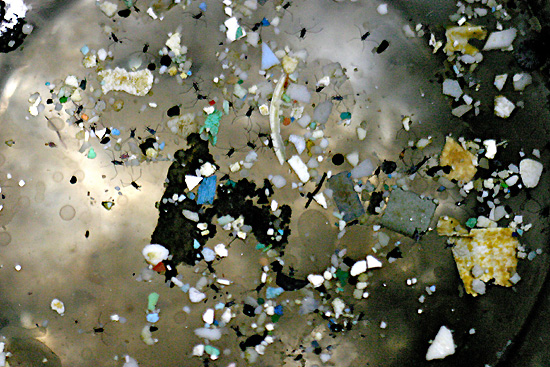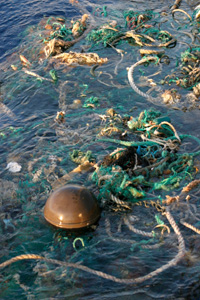Project Kaisei confirms vast plastic debris island in Pacific
 Print This Print This
By Project Kaisei
Press Release
Friday, Aug 28, 2009
Kaisei Releases Initial Findings of North Pacific Gyre Discovery Expedition
 |
| The discovery portion of Project Kaisei confirms "the presence of plastic debris in the Pacific Ocean is pervasive". (T. Brajkovich) |
|
Startling Confirmation of Plastic Debris of All Sizes found in the Gyre
SAN FRANCISO, CA (Aug. 25, 2009) - After 22 days of intensive research, testing and collection in the North Pacific Ocean, the tall ship Kaisei has completed the discovery portion of its expedition, confirming fears that the presence of plastic debris in the Pacific Ocean is pervasive.
 |
| Kaisei (T. Brajkovich) |
|
Project Kaisei set off to the August expedition with a three-pronged mission: to develop a sound scientific sampling of the Marine Debris in the North Pacific Gyre, to test and assess various Marine Debris prototype harvesting/reclamation technologies, and to gathering insight on solutions to a possible cleanup in future expeditions. Project Kaisei aims to use scientific data and results for education and public awareness aimed at bringing about real social change to halt the flow of Marine Debris into the world’s oceans.
Initial Findings:
The scientific team on board Kaisei conducted research in a grid of 17 sampling sites, studying and detailing debris and invasive species and conducting more than 50 surface debris sampling trawls, each one to two hours in length; 15-minute trawls were conducted four times per night during the second phase of the expedition.
While debris was recorded at every stage of the expedition, since day one, a steady increase of debris was recorded in trawl samples as the ship moved deeper into the North Pacific Gyre. Every sample taken within the Gyre contained plastic debris, from ultra-fine to very large.
 |
| A "Monster" of the plastic vortex.(T. Brajkovich) |
|
"More than 30 years ago, on my first trip to the North Pacific Gyre, I found a few glass ball fishing floats, one net and there were, in four days, perhaps two pieces of floating plastic,” said Mary T. Crowley, Project Kaisei co-founder and Ocean Voyages Institute executive director. “Returning now with Project Kaisei and researching the marine debris situation shows a startling change in this same area. In 30 minutes one easily can count up to 400 pieces of plastic on the sea's surface."
The Kasei scientific crew also recorded finding a variety of invertebrates living on the debris, including swimming crabs, sea anemones, barnacles, sponges, algae, which may be problematic both for invasive species proliferation and the effect from possible toxins on the debris. Sea life was also noticed in ghost nets (derelict fishing gear) that had perished due to entanglement.
 |
| Fish eggs on plastic. (T. Brajkovich) |
|
Next Steps:
Upon the ship’s return, the materials sampled and collected during the expedition will undergo extensive laboratory testing and scientific analysis on shore. Laboratories will be looking for toxins such as DDT, PCB, BFR and, PAH in addition to conducting other tests. The results of these tests will provide Project Kaisei with many answers to the extent marine debris are impacting the ocean environment and sea life as well as lead us to new questions and the direction of mission’s and future research.
 |
| Researchers diligently cut through debris island.(T. Brajkovich) |
|
Working in collaboration and with support from Project Kaisei, the research vessel New Horizon operated by the Scripps Institution of Oceanography departed San Diego on Aug. 2, with Project Kaisei co-Founder and Project Director Doug Woodring aboard. “One thousand miles from shore, with no sign of human life for days, our human "footprint" is now apparent in even one of the most remote places on the planet,” Woodring said. “It was sad to see the amount of small pieces of plastic, continuously, in all of our sample nets within the gyre area, in more than 1,200 miles of sampling. This should be a message to everyone that our consumption patterns, and ways we dispose of products, have failed us for this to have occurred.”
Scripps scientist’s research focused on surveying plastic distribution and abundance, collecting samples for analysis on land, and assessing the impacts of debris on marine life. Their initial findings will also be released to the public in the coming months.
Project Kaisei
For more information, please visit:
Exploring the Great Pacific Garbage Patch
Project Kaisei
Ocean Voyages Institute
 Print This Print This

|

